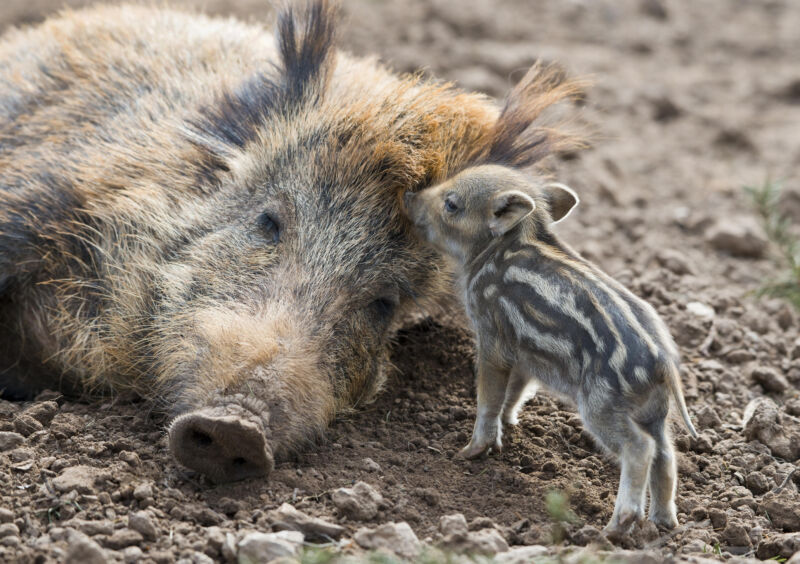
Pigs have a long and illustrious history in North America. According to the University of Mississippi, they were initially introduced to the continent from Europe in the 1500s. In the 1900s, the Eurasian wild boar was also introduced. Over the years, escapee pigs and the introduced boars interbred, creating a nuisance: wild hogs.
These hogs have captured the imagination of the US. In 2019, a tweet asking a “[l]egit question for rural Americans” went viral. The question: “How do I kill the 30-50 feral hogs that run into my yard within 3-5 mins while my small kids play[?]” There was even a TV show, called American Hoggers, about hunting these pigs, and it ran for four seasons starting in 2011. One of its stars, Dean Campbell, passed away over the summer. A small industry offering the experience of a lifetime—i.e. shooting hogs from a helicopter—also sprang up. If this seems somewhat macabre, it’s worth noting that feral pigs can cause $1.5 billion in damages in the US each year—though it’s hard to say if this makes using assault weaponry against them any less gruesome.
At any rate, new research suggests that by using temperature and terrain, we can anticipate where these hogs are more likely to trot as they continue expanding across the continent. According to Lindsay Clontz, one of the paper’s authors and a University of Georgia masters’ graduate in forestry and natural resources, this could help the US manage the damage more effectively.
Predicting the pigs
Clontz and her colleagues captured 49 wild pigs and put radio collars around their necks to track their movement over a year in a 310-square-mile area in South Carolina near the Savannah River. According to the research, pigs generally make their homes in places that are near water. That's partly for the obvious need to hydrate but also because pigs are bad at regulating their body temperatures, and bodies of water can help them stay cool.
“Pigs are one of the most adaptive generalist invasive species. [But] they don’t thermoregulate well. We found in our study that they tend to confine movements to areas that have good thermal cover—whether that’s canopy cover or areas close to streams—to be able to cool themselves off in hot temperatures,” Clontz told Ars.
The team also used air pressure as a proxy for weather—barometric pressure going up usually means clear weather is on the horizon, while lowering pressure may mean a storm or rain. When there’s low pressure, the wild hogs tend to “stay inside” or stick near their home ranges to take advantage of cover. During periods of low air pressure, they may venture a bit farther out.
In general, the Savannah River has two different types of terrain: upland pines and bottomland hardwood. The latter is preferred real estate for pigs, both because it can help pigs thermoregulate and because it's particularly productive. When pigs live in bottomland hardwood, they tend to move around, compared to pigs living in less productive habitats.
“They have a lot of forage, places you can find water easily, and a lot of cover as well,” Clontz said.
Where the stars align
According to Clontz, this research can help people at every level—from farmers to federal agencies—anticipate when and where feral hogs are most likely to strike. Most of the necessary information about feral hog movements, like weather and vegetation, can be easily found online.
"You can say, 'Here’s where I'm going to devote resources' or 'Here's where I’m going to have traps; here's where I'm going to put bait stations,'" she said, adding that other control methods can include aerial shooting and other forms of hunting. "[This research] helps us be more efficient and effective with our resources."
Clontz noted that her work only directly applies to pigs near the Savannah River. But some of these variables—like habitat quality—are likely to be universal across the continent, she said.
Beyond damaging crops and outcompeting native species, wild hogs can also be vectors for disease for pigs or even other animals. Some places around the world are facing outbreaks of African swine fever, for instance. As such, Clontz said her research could help inform better epidemological decisions as well.
"Where the stars align, where you have streams, where you have this high-quality habitat, where you have optimal weather, you’re going to have more wild pigs," she said. "Where you have these wild pigs [in high densities], those are probably going to be your disease hot spots."
Pest Management Science, 2021. DOI: 10.1002/ps.6701 (About DOIs)
reader comments
117